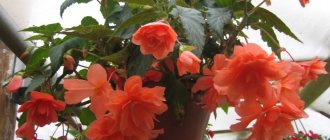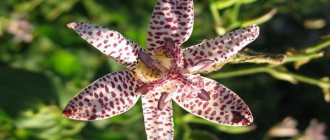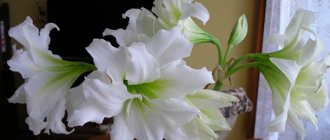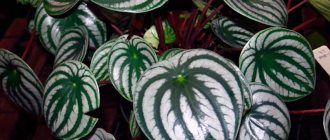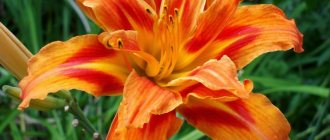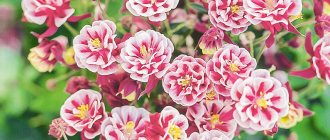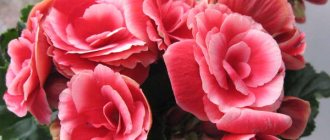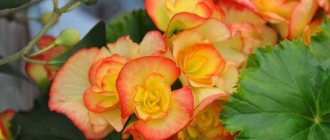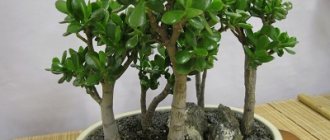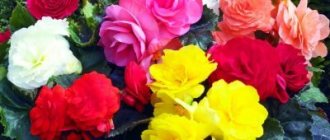Characteristics of the subspecies
A subspecies of tuberous begonias is ampelous, and can also be called cascading or pendula. The latter are often sold in stores as a series of varieties of hanging begonias, with differences in color characteristics.
These are herbaceous plants with a succulent stem, tuberous roots and asymmetrical toothed leaves. The main interest for gardeners is its flowers. Terry varieties of hanging begonias have male and female flowers. The male ones are larger and bloom first, the female ones appear later and are non-double in the structure of the bud. It turns out that one bush can have both double and non-double inflorescences at the same time.
With proper care, the flowering of tuberous begonias is lush, to the point that the foliage is practically invisible because of the flowers. The petals come in different shades of yellow and red, orange, pink, coral and salmon. There are varieties in which the edge of the petal is edged with a different color.
The sizes of flowers vary from small - 2-3 cm in diameter, to giant - 15-20 cm. They are also different in shape: double and regular, similar to roses, peonies, camellias and even daffodils. During the period of active flowering, pendula bushes turn into lush “caps” of bright colors.
Due to the characteristics of hanging varieties, they are used mainly for landscaping terraces and balconies, loggias, shop windows, grown in hanging boxes and flower pots. It grows quite well at home, however, in the warm season it is still preferable to send it to fresh air.
Choosing a place in the apartment
It is imperative to decide on the place where the plant will be most comfortable. On a southern window, the plant will be disturbed by the scorching sun; on windows oriented to the north, the begonia will stretch out due to lack of light, leaves and flowers will begin to fall off, and the plant will lose its decorative properties.
It is ideal to place the flower on a glazed balcony, or if there is none, on a southwest or southeast window.
The plant, depending on the variety, feels better in the sun the larger its inflorescences. The flowering of begonias stops if there is not enough light and there is no constant flow of fresh air. At the same time, you need to beware of drafts so that the fragile succulent shoots do not break.
Popular varieties
Garden begonia 'Illumination Apricot'
Some varieties of hanging begonias are combined into series. For example:
- Illumination – plants of this series grow quickly, branch well and bloom luxuriantly. Shoots up to 30 cm hanging. Double flowers with a diameter of 5 to 7 cm. The series is presented in four colors. The most popular variety in the series can be safely called Illumination apricot.
- Sensation is a dwarf cascading begonia with very large double flowers up to 10-12 cm in diameter. The series is particularly resistant to bad weather conditions.
- The variety series Opium, or Odorata, are compact bushes with shoots up to 25 cm and large double flowers up to 10 cm. These begonias are distinguished by the presence of a delicate aroma. Varieties: Begonia Odorata Fragrant Red, Odorata Pink Delight, Opium Red, Opium White
Begonia "Champagne"
And also Cascade Apricot Gold, Double Dark Red and the mesmerizing beauty of Cascade Picotee Florence.
"Cascade Picotee Florence"
Reproduction
There are three ways to get a new plant.
Seminal
Begonia has very small seeds, similar to pollen, so for uniform sowing they should be mixed with sand or ash. This flower is planted for seedlings in January, since hanging begonias need a lot of time to develop.
Caring for baby ampelous begonias is approximately the same as for many other sprouts obtained from seeds. Maintaining a cool temperature (about 19 degrees), two timely picks, as well as fertilizing. Sprouts tolerate transplants well. The flower is planted in a permanent place only after constant warmth has established itself outside.
Young nodules form during the first year of the plant's life. Some experts consider the disadvantage of seed propagation to be the possibility of cross-pollination of different varieties, which leads to a loss of clarity of varietal characteristics. More information about growing begonia from seeds can be found here.
It will be useful to read:
Growing viola from seeds It is difficult to find a plant more charming and beloved by gardeners than viola or violet. And not only gardeners, people...
Cuttings
The process of propagation by cuttings is simpler, however, it also has its difficulties. This is done in spring or autumn. The apical stalk with at least two buds is twisted out of the tuber. The broken areas are treated with crushed coal to prevent rotting. The resulting cuttings are dried for half an hour and then treated with a root formation stimulator.
Then there are two ways: lower it into a deep glass of boiled water, or stick it into nutrient soil.
When choosing the first method: pour just a little boiled water into a tall glass and add a charcoal tablet. Place the cutting on the tablet so that the tail is immersed in water by 1-2 mm. Next, it is necessary to constantly maintain this water level. On the first day, you can cover the glass with a bag, but not for long, because... Too much humidity will cause the stem to rot.
It is important to know! Rooting in water occurs less frequently. And successfully rooted sprouts often do not live long and die after one flowering.
The second method: planting cuttings in nutrient soil or peat tablets with a greenhouse effect (glass cover).
After 2-4 weeks they will take root. After another 1-2 weeks, the rooted cuttings are planted in a pot with prepared soil. You can take a universal mixture by adding a small amount of perlite and coconut substrate. Cover the begonias with a bag until signs of growth appear. All care for ampelous begonias in the first year consists of maintaining the necessary soil moisture without fertilizing.
Tuberous
The ampelous begonia also reproduces by cutting the tubers. The method preserves varietal characteristics as much as possible. To do this, at the beginning of winter, before germination, large and healthy specimens are selected, capable of producing five to nine sprouts.
As a rule, such tubers are more than two years old. The forcing process for them begins earlier than others, because greens are growing slower than usual. The tuber is placed in a moistened mixture of peat and sand. At the same time, the room should be warm and humid.
As soon as the buds begin to hatch, the nodules are removed from the ground. Carefully cut in half or into quarters so that each part has two or three buds left. The body of the slices is treated with a solution of strong potassium permanganate and dried.
Further germination occurs by analogy with ordinary tubers. But make sure that when watering, water does not get on the cuts.
Possible problems
When growing hanging begonia from a tuber, some problems may arise:
- If the leaf blades begin to curl upward and dry at the edges, it means that the plant is exhausted by the hot air in the room. It is recommended to move the begonia to a cooler room and spray the air around the plant.
- If the leaves look drooping and turn yellow, then the reason lies in the fact that the plant is kept in a cold room. To prevent yellowing of the foliage, the begonia should be moved to a warm room.
- If the foliage becomes smaller and there is no flowering, the plant is experiencing a deficiency of mineral or organic fertilizers.
Corrected shortcomings in time will save the begonia from death, and it will thank you with abundant flowering.
Caring for young begonias
When the new begonias gain strength and grow noticeably, you need to pinch the top for better branching of the bushes.
During the first winter, the young plant does not need to be sent into hibernation, but it will have to be illuminated. In the spring, you should pinch off all elongated shoots and transfer the grown flowers into pots or flowerpots 15-20 cm wide. Often, for a spectacular flower cascade, several tubers are planted in large pots, for example, 2 begonia tubers will fit in a wide rectangular flowerpot 50 cm wide.
It will be useful to read:
Planting and caring for anemone An ancient Greek legend says that the anemone grew from the tears of Aphrodite, mourning her murdered lover. Beautiful…
Begonias in the garden
Landing location
When choosing a place for future cultivation, you must remember that in its homeland, ampelous begonia lives in the subtropics. Therefore, I got used to the bright but scattered sun. In summer, it is better to take flowers out into the fresh air, placing them in bright places under the direct sun, ideally in diffuse shade. Begonias need a well-lit habitat, but they really do not like heat.
When there is insufficient light, they stretch out, and in the heat the branches become exhausted. In both cases, the bushes do not gain powerful green mass, and therefore flowering becomes scarce or development stops altogether.
Priming
Ampelous begonia loves light nutritious soils, such as chernozem, but does not tolerate hard soil and crust on its surface. Therefore, the soil must be loose, breathable and nutritious.
Sandstone enriched with leaf humus and peat is perfect. This soil mixture will create excellent conditions for the drainage of excess moisture and saturation of the roots with air. If the site is dominated by heavy loamy soils, you can dilute them with the same sand, peat or leaf humus.
Watering
This beauty loves water. However, watering during the growth of green mass should be more frequent and abundant than during flowering. Overdrying the soil is less dangerous than flooding, but it is best to avoid it. It is better to water in the morning or evening, before the sun reaches its peak activity, with soft, settled, warm water.
Avoid getting water on the leaves - this can cause burns.
Feeding
It is best to feed the plant once every 2 weeks with universal mineral fertilizers, for example, Kemira Lux (N:P:K - 16:20.6:27.1) or similar. But if you overdo it with organic matter, the green mass of the plant will grow actively to the detriment of flowering.
Rest period
In early autumn, the leaves of tuberous begonia turn yellow and gradually fall off. At this time, remove all fertilizing and reduce watering to a minimum.
When only one tuber remains from the begonias, they are dug up and dried in a warm room for one to two weeks. Then they are sprinkled with sand or peat and sent to the cellar or any unheated room. Ampelous begonias do not require any other care at this time.
How to germinate ampelous begonia seeds
The seeds of the decorative crop are germinated on thin cotton fabric. To do this prepare:
- a piece of gauze;
- flower seeds;
- water.
The gauze is moistened generously and transferred to a convenient container. Seeds of decorative crops are placed on top of the cotton fabric. The container is transferred to a bright and warm room. After 2 days, the seeds will begin to germinate.
Important! Germination of planting material allows you to accelerate the emergence of seedlings and achieve early flowering.
Common Difficulties in Growing Begonias
Sometimes during the growth process of ampelous begonias, disruptions occur and buds appear earlier or simultaneously with the leaves. In this case, it is necessary to cut off all the buds to stimulate the formation of the first foliage. Otherwise, the first buds will most likely be non-double or mutate in some way. After this pinching, you should fertilize the bushes once a week with mineral fertilizer in the ratio N:P:K - 20:20:20.
Also, when shoots bloom profusely, it often happens that the shoots cannot withstand their own weight and break off. This can be prevented by tying the plant to special decorative supports in advance.
Top dressing
For good growth and intensive flowering of cascade begonias, fertilizing the soil is necessary. In early spring, fertilize with nitrogen once, and after a short period of time with potassium concentrates. Mineral fertilizers are suitable during the flowering period. It is permissible to apply organic ones only a couple of times during the summer season.
The plant is highly sensitive to salinity, and to prevent this from happening, it is better to apply fertilizer more often, but little by little. This is safer than one-time intensive feeding.
The queen of flower beds and her neighbors
Ampelous and cascading begonias look great on their own - in hanging containers for vertical gardening, either in the garden or indoors.
However, you can use its ground cover property when creating the center of alpine slides or raised flower beds.
It will look great with any green plants. For example, next to a cineraria pubescent with silvery hairs. Its delicate and modest branches perfectly highlight the beauty of begonia.
Also, begonia often coexists in flower beds with marigolds, chrysanthemums, asters, and bells. The main condition is that the plants must not only look beautifully combined, but also have similar growing conditions. It would also be wise to combine plants with different flowering periods in the flowerbed - so that when some fade, others bloom.
Pests and diseases
Among the misfortunes that beset cascade begonia are gray rot or powdery mildew. Typically, fungal diseases affect the plant when the soil is over-moistened. Monitor the condition of the plant, paying attention to the condition of the lower leaves of the begonia and the core of the bush. If inspection reveals affected leaves, remove them immediately and reduce watering. Move the plant to a room where the temperature is higher and the humidity is lower. Treat the begonia with a fungicide and isolate it from other flowers.
Watch the plant carefully and learn to understand its signals: if the leaves begin to dry out at the edges, you need to take care of increasing the air humidity. The leaves are curled and dry - the room is too hot, they turn yellow and rot - the soil moisture is very high, the leaves are curled and dry - it is too hot. It seems to you that the plant is sick, but there are no visible reasons - dig up and examine its roots, their condition will show the cause of the flower’s illness.
